The motivating story of the "Union"

There are people, books, films that motivate. Often there is a story when the hero initially fails, but then he achieves great success later or in another area. The history of technology can also motivate. The ship "Soyuz", which was originally created for the lunar program, did not take people to the moon. The first flights did not go perfectly either - missions were disrupted, accidents occurred, even people died. But new modifications appeared, the ship was getting better, and now it is the safest and safest manned ship and will soon beat the Space Shuttle record for 135 flights and will become the most flying ship. And it’s not a fact that in the future there will be ships that can outrun it in terms of the duration of the program - the first unmanned flight of the Soyuz took place almost 50 years ago.
Names and Indexes
The beginning of work on what the ship "Soyuz" grew from is called 1962. The new ship was designed to fly around the moon. But the indices and ship names in different sources are different - “North”, 5K, program “A”, 7K.


')

Despite the difference in indices and names, the “headlights” of the “Soyuz” descent vehicle and the cylindrical instrument-modular compartment with a thermoregulation system are already quite recognizable in the figures. The unusual form of the descent vehicle was needed for the moon. If the “ball” of the “Vostokov”, on which the first astronauts flew, braked in the atmosphere when descending from near-earth orbit with an overload of ~ 9 “same”, then when returning from the moon, a ballistic descent would lead to an overload of more than 12 “.” In addition, the uncontrolled descent required a very small entrance corridor - several kilometers higher, and the ship would have rebounded from the atmosphere, several kilometers below - and the ship would burn with an overload of more than 20 "same." And, finally, the landing area was very large, which made it difficult and expensive to search. A "headlight" created lift, allowing you to control the braking process, increasing the permissible error of overload in the corridor of entry into the atmosphere, reducing overload and reducing the search area.
Rush
If for 1962 the USSR was in the lead in the space race, then by 1965 the United States had already begun to pull ahead. At the end of 1965, “Gemini-6A” became close to “Gemini-7”, and, although the formal joining did not take place, it was obvious that the Americans came very close to this task. And the new Soviet ship, able to maneuver and dock and received as a result the index 7K-OK, was still not ready. In early 1966, SP died suddenly. Korolyov, and Vasily Mishin, who replaced him, lacked something to keep the program tight on the tracks. The rush began. In the first unmanned launch, Cosmos-133 almost immediately spent fuel on orientation engines. Normal braking did not work, the MCC managed to brake the ship with a sequence of short pulses, but the vigilant detonation system considered that the ship could miss the territory of the USSR and destroyed it. The next unmanned Soyuz did not even receive a name - due to the absence of ignition in one of the combustion chambers, the rocket did not start, and the emergency rescue system, for which the Earth’s rotation was forgotten to take into account, was “saved” by a working ship. The next unmanned "Soyuz" - "Cosmos-140" was not able to fully carry out the test program, squandered fuel, and when it landed a hole burst in its bottom, and the ship sank in the Aral Sea. It would seem that it is necessary to eliminate the comments, launching unmanned ships. But the next launch was planned manned, and on a very ambitious program. In the first launch, the docking of two manned spacecraft was planned with the transfer of astronauts between them through open space. On April 23, 1967, Soyuz-1 started with Vladimir Komarov ... The unexplored solar panel put an end to the flight program, Komarov with great difficulty, manually, guided the ship to braking, but it was all for nothing. During landing, the parachute system failed, and Vladimir Komarov died. 18 months was spent on correcting errors, and six unmanned ships were used on test flights.
7K-OK
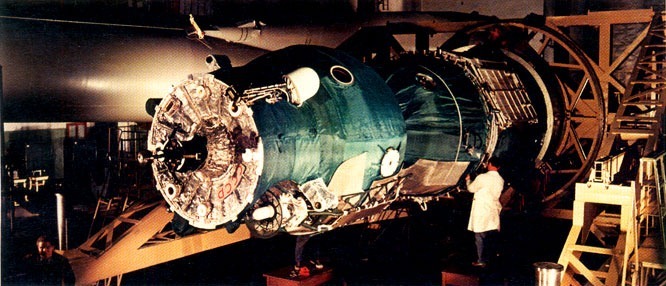
In October 1968, Soyuz-3 with cosmonaut Georgy Beregov went into space. Ambitious to the adventurousness of the manual docking on the night side did not work. The weakness of the new ship manifested itself - the mooring and orientation engines (DPO), working on hydrogen peroxide, had a very small supply of fuel. There was no reserve for the mistakes of people and technology.
DPO "Soyuz-19", the same as on earlier ships
The first manned success of the "Union" was the flight of the "Union-4" and "Union-5". For the first time two manned spacecraft docked (the Americans used a special unmanned target), which allowed the Soviet media to announce the creation of the first space station. Accident, but the future success of the "Union" will be associated with them. And in that flight the ship showed its best. The accident at the Soyuz-5, because of which he entered the atmosphere backwards, did not lead to the death of the astronaut. The strength reserves were enough to withstand time, until the instrument-aggregate compartment, which was not completely separated, burned off and fell off under the pressure of the atmosphere. And then the descent vehicle turned into the correct position on the Vanka-Vstanka principle.
Preserved unique shooting interior and appearance of the ships.
In the original version of the 7K-OK, "Unions" flew to index 9.
7K-L1
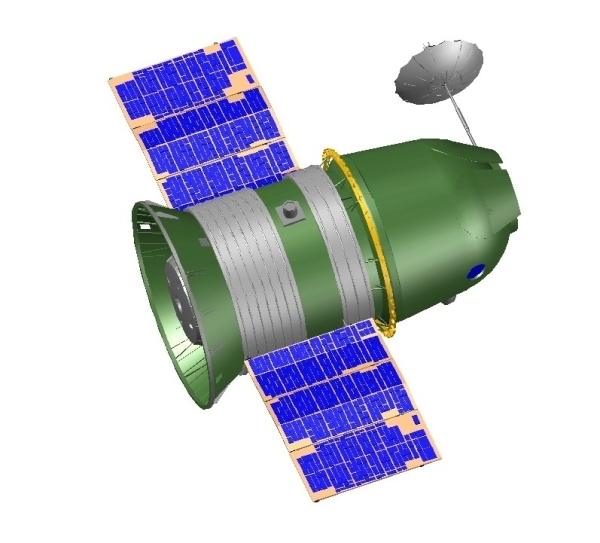
Things were less successful with the lunar variant. From 1967 to 1970, 14 launches were made. First, the ship was launched into a highly elliptical orbit, testing the possibility of returning from the moon in principle, then, from Zond-5, 7K-L1 began to fly around the moon. On Zond 5, turtles, fruit flies and hruschaks successfully flew to the Moon and returned alive. In subsequent ships there were accidents that would threaten the life of astronauts if they were on board. And the meaning in the moon race after the victory of the Americans disappeared. The program was closed. Curiously, the Proton was to be used as a launch vehicle, and unusual looking Proton photos with a rescue system for manned flights were preserved.

7K-T

After the success of the Americans with the Moon, the USSR decided to respond asymmetrically, focusing on orbital stations. For this, a 7K-T “transport” modification was developed, which differed from the basic one, mainly by the presence of a docking device with the hatch, so that the cosmonauts would not have to go to the orbital station through open space. Soyuz-10 managed to dock, but failed to open the hatch. The first crew of the first long-term orbital station were Dobrovolsky, Volkov, Patsayev on the Soyuz-11. But during the return, due to the spontaneous opening of the breathing valve in space, the astronauts without spacesuits died. The flight program was stopped for 27 months, and the Soyuz 7K-T became noticeably different apparatus. First of all, the astronauts began to fly in spacesuits. The additional weight and emergency supply of oxygen led to the fact that the ship from three-seater became two-seater. Due to other improvements, the ship was still heavy, so the solar batteries were removed, and there were enough batteries for two days of flight to the station.
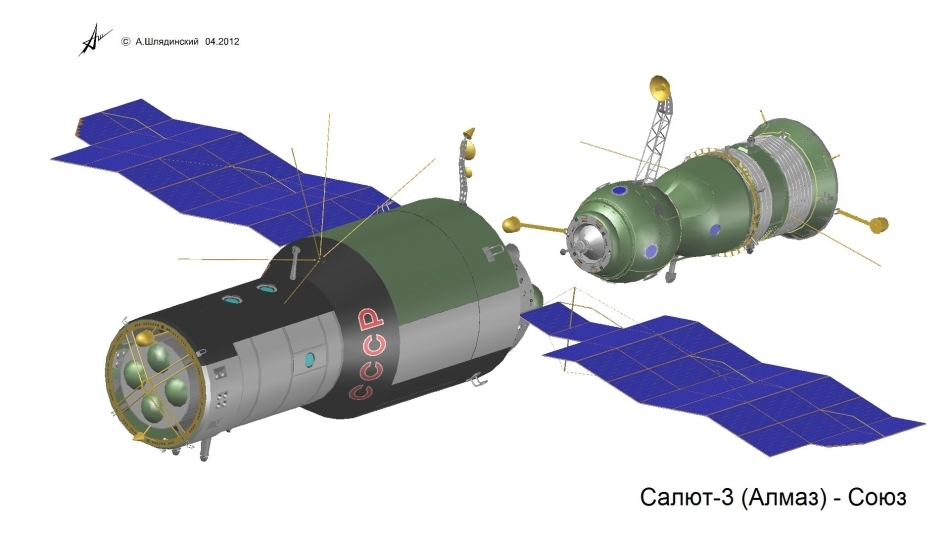
Ships of this modification flew right up to 1986. One of these ships was the Soyuz-35, for which there is a 360 ° panorama . It is very interesting to look at old appliances.
7K-TM

The political decision on the joint flight of the USSR-USA "Soyuz-Apollo" became the task of national importance in the USSR. And if the United States used the standard Apollo, then in the USSR a whole special modification of the Union was created. The solar batteries were returned to the ship, the autonomous flight resource was increased from 3 to 7 days, a new docking station APAS was developed for docking. In addition to the "Cosmos", which designated unmanned test flights, a modification of the 7K-TM was checked in a manned flight "Soyuz-16". After the successful flight of the Soyuz-19 with the Apollo, the reserve ship was loaded with scientific equipment and sent to autonomous flight as the Soyuz-22.
7K-S, 7K-ST

For the "Union" in parallel developed military modifications . They didn’t fly in military form, but the serious improvements that were developed for them led to the appearance of a new modification of the ship - 7K-C and 7K-ST, which were officially designated as Soyuz-T. An argon-16 on-board digital computer appeared on the ship, the solar batteries were returned, and the crew managed to increase to three people. Finally, the ship lost its big disadvantage - mooring engines and orientation to hydrogen peroxide. In the new propulsion system, the DPO and the main engine operated on heptyl / amyl from the same tanks. Thanks to this, we were able to remove the backup engine - in case of failure of the main main engine, the ship could return to Earth, braking on the DPO. A fuel was enough to correct the error of people or technology.

New dashboard
"Unions" with the index -T flew to the "Salyut" -6 and -7 in the early 80s.
Tm

For the new multi-module station "Mir" made a new modification of the "Union". The new approach and docking system Kurs has rescued the orbital station from having to turn when the ship is approaching. In addition, they reduced the mass of parachutes, improved the engines of soft landing and rescue system.

This is Soyuz TMA, but the new antennas and feed are the same.
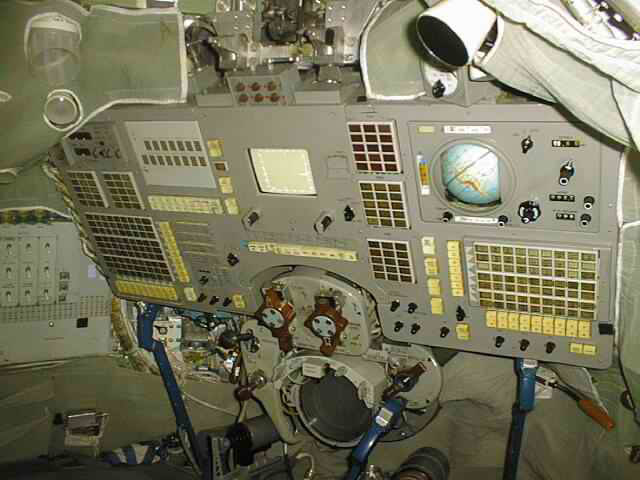
Cosmetic cab changes - scales are now not mechanical, but electronic
Unions TM flew from the mid-80s to 2002.
Tma
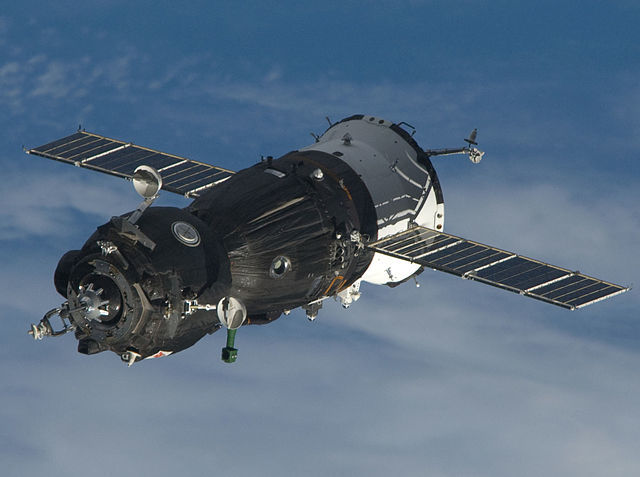
Americans, accustomed to the space of the space shuttles, were greatly surprised at the restrictions on the growth of our astronauts. It was somehow wrong to deprive a large part of the American astronaut detachment of the ability to fly to the ISS, so I had to develop a new modification of the spacecraft. In the new "Anthropometric" "Union" could fit much larger astronauts. Other improvements were minor.
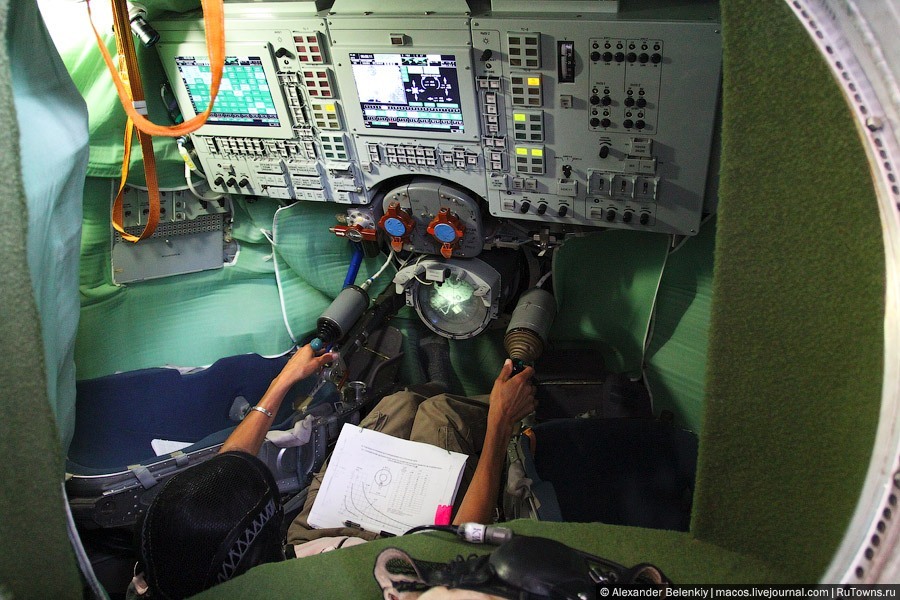
New large displays
Ships of this modification flew from 2002 to 2010.
TMA-M

By 2010, it became clear that it was time to update the e-filling. The onboard computer weighing in centner is somehow too much. No sooner said than done, the TMA-M modification reduced the mass of a computer and several other devices by half. Energy consumption has also decreased.
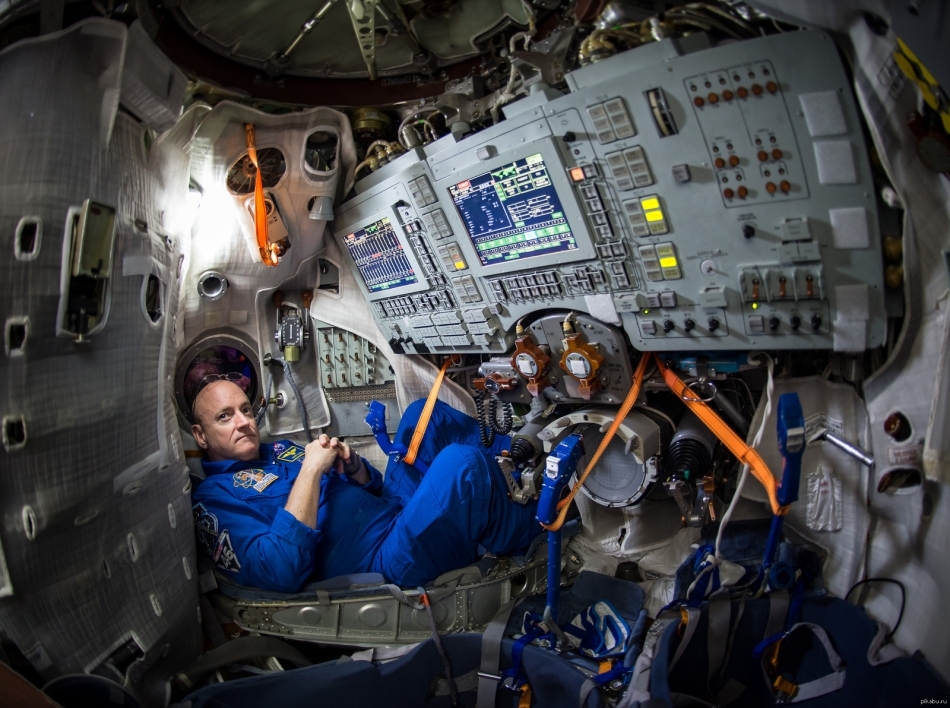
Full size photo
MS
And, finally, the last in time, and it seems, the final modification of the MC. New connection without a
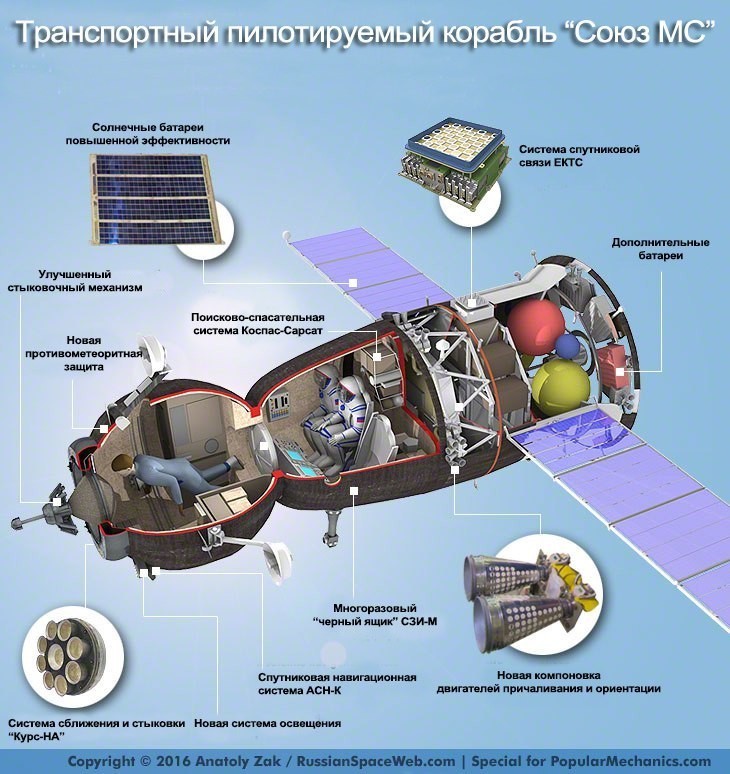
Additional Information
The history of the flights of the Soyuz according to modifications until 2002.
In more detail about the design of the ship "Soyuz" in comparison with the "Apollo".
A small announcement : From July 14 to July 17, the Sea of Clarity festival will be held at the Moscow Museum of Cosmonautics . There will be astronauts, industry representatives and popularizers (including me). For foreign people promised to broadcast on the Internet. Come.
Source: https://habr.com/ru/post/395849/
All Articles